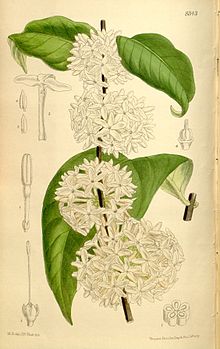| Pleiocarpa mutica | |
|---|---|

| |
|
Scientific classification
| |
| Kingdom: | Plantae |
| Clade: | Tracheophytes |
| Clade: | Angiosperms |
| Clade: | Eudicots |
| Clade: | Asterids |
| Order: | Gentianales |
| Family: | Apocynaceae |
| Genus: | Pleiocarpa |
| Species: | P. mutica
|
| Binomial name | |
| Pleiocarpa mutica | |
| Synonyms [2] | |
| |
Pleiocarpa mutica is a plant in the family Apocynaceae.
Description

Pleiocarpa mutica grows as a shrub or small tree up to 7.5 metres (25 ft) tall, with a stem diameter of up to 5 cm (2 in). Its fragrant flowers feature a white corolla. The fruit is yellow to bright orange with paired follicles, each up to 2 cm (1 in) long. Local medicinal uses include as a treatment for stomach-ache, kidney diseases, malaria, jaundice and as a laxative. [3]
Distribution and habitat
Pleiocarpa mutica is native to an area of tropical Africa from Sierra Leone east to the Central African Republic. [2] The species is found in a variety of habitats from sea-level to 600 metres (2,000 ft) altitude. [3]
Phytochemistry
The alkaloid kopsinine, which has in vitro anticholinergic activity, has been isolated from Pleiocarpa mutica. [4]
References
- ^ Botanic Gardens Conservation International (BGCI).; IUCN SSC Global Tree Specialist Group (2018). "Pleiocarpa mutica". IUCN Red List of Threatened Species. 2018: e.T136110351A136110353. doi: 10.2305/IUCN.UK.2018-2.RLTS.T136110351A136110353.en. Retrieved 20 November 2021.
- ^ a b c "Pleiocarpa mutica". Plants of the World Online. Royal Botanic Gardens, Kew. Retrieved 30 August 2020.
- ^ a b Medicinal Plants. PROTA. 2008. pp. 468–469. ISBN 978-9-05782-204-9.
- ^ Naaz, H.; Singh, S.; Pandey, V. P.; Singh, P.; Dwivedi, U. N. (2013). "Anti-cholinergic alkaloids as potential therapeutic agents for Alzheimer's disease: an in silico approach". Indian Journal of Biochemistry & Biophysics. 50 (2): 120–125. PMID 23720886.
